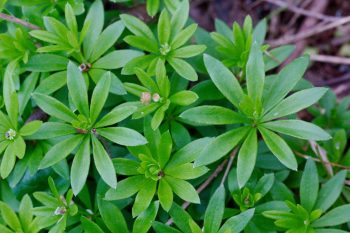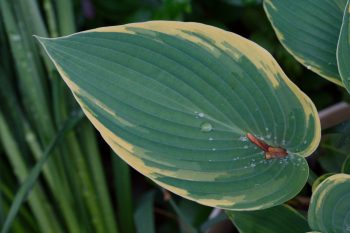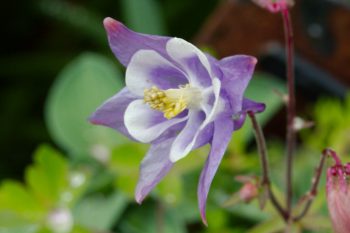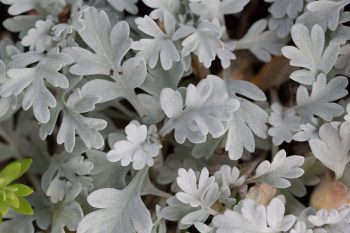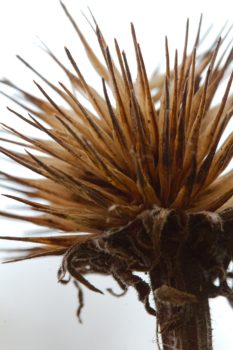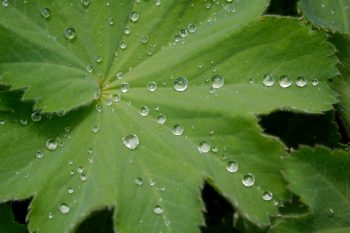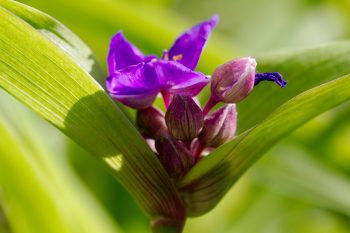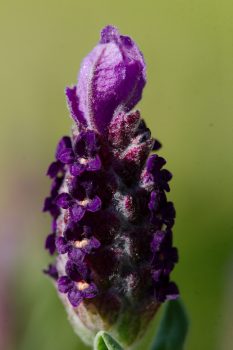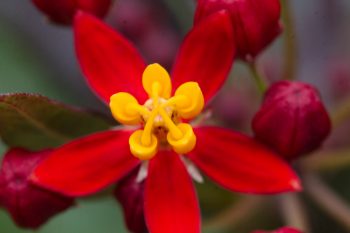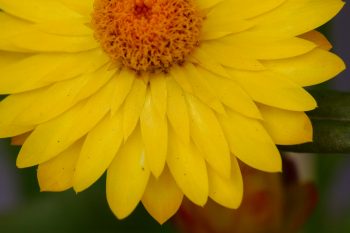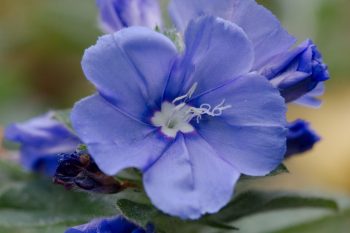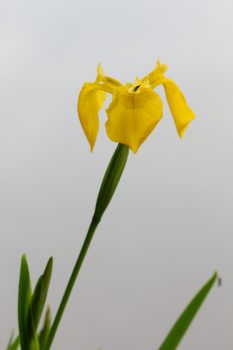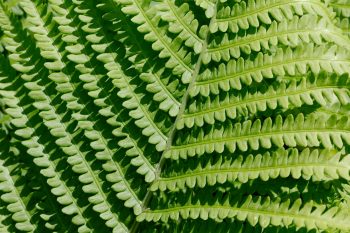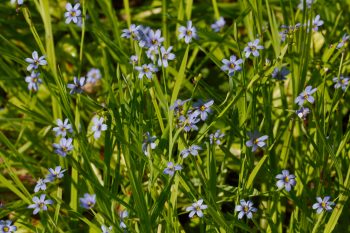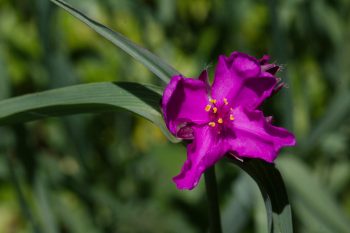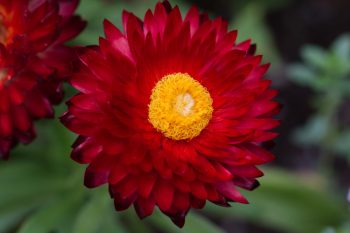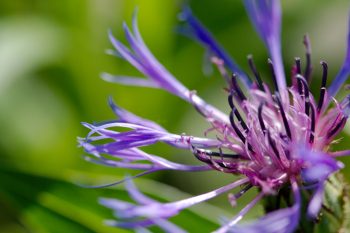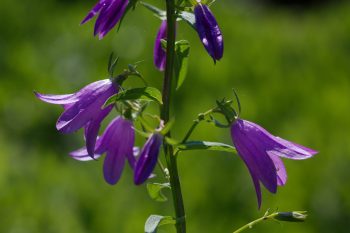This will start blooming in a week or so, but even before it’s in bloom, sweet woodruff (Galium odoratum, also known as sweetscented bedstraw) is quit pretty. In fact, I’d say this photo doesn’t do it justice. The shades of green are just lovely and it makes a really nice groundcover where you don’t need something evergreen. We have a few patches of this and I really like it where it is. It isn’t too aggressive and it fits in very nicely. When crushed, it gives off a strong odor of freshly mown hay, even more so as the plant dries.
Tagged With: Herbaceous Perennial
Galium odoratum (Sweet Woodruff)
Hosta Leaf
Cathy bought a couple hosta plants last year and put them in a container in the front of our house. If we grow them quite close to the house they do reasonably well but the deer and rabbits really seem to like them and if they are farther from the house, they get eaten. Of course the slugs are just about as likely to get them close to the house, but they don’t consume an entire plant over night. This one, called ‘First Frost’, is one of the two that are in this container and it such a pretty little things.
Columbine (Aquilegia)
We have a number of different columbines in our yard and garden. This one is growing in a container just outside our front door. This is a relatively simple columbine flower, close to what you’d find in the wild. Some others that we have are much fancier and I’ll probably have photos of them in the days to come. They are a reliable bloomer and well worth adding to your garden, blooming after the bulbs are mostly done and before the summer blooms start, so they fill an important role in the garden plan.
Dusty Miller
Dusty Miller (Jacobaea maritima, a.k.a. Senecio cineraria) is a marginally hardy, herbaceous perennial. It’s hardy here, anyway. We have it growing in an urn-shaped container near the end of our driveway and it seems happy enough. It does have flowers but they are not particularly ornamental and many people prune them off so as not to distract from the foliage, which is what the plant is generally grown for. It does well in both shade and sun and really takes very little care.
Echinacea purpurea
This is purple coneflower (Echinacea purpurea) although obviously there isn’t any purple color here right now. These are last year’s seeds, which we generally leave up all winter for the birds. They are obviously well fed, because by spring, most of them are still here. It’s just about time we cleared them all out. Most of the black-eyed Susan seed stalks have been cleared, although we’ve left some yet.
I was on the ground taking photos of a columbine (Aquilegia) and happened to notice this coneflower stem next to me, so I rolled over on my back and took a few shots, hoping to get a little detail in the seeds, which were seriously back-lit by the sky. This one turned out pretty well. I would have liked to get a little further away, as well, but I was looking nearly straight up and getting further away would have required that I dig a hole to get into. So, not going to happen.
Alchemilla mollis ‘Auslese’
It’s a week early for Mother’s Day but we’ve been cooped up for too long and we didn’t want to wait until next week. We took our annual trip to Fehr’s Nursery early this afternoon and Cathy bought a load of plants. As usual, I wandered around and took photos of flowers, etc. I got some nice pictures of various hens and chicks (Sempervivum varieties) including some Sempervivum arachnoideum, which have what look like cobwebs on them. I decided to go with this photo, however, of lady’s mantle leaf (Alchemilla mollis ‘Auslese’) with water droplets on it.
Uvularia perfoliata (Perfoliate Bellwort)
It was quite cool this morning after a soft freeze over night. There was ice in both bird baths this morning, not just the pedestal meaning it got pretty cold. I had covered my recently planted camellias and we moved some pots into the garage, so everything seems fine. We went for a very nice walk in Rock Creek this afternoon and saw lots of pretty things, including this perfoliate bellwort (Uvularia perfoliata), a pretty little wildflower we don’t see very often. The word ‘perfoliate’ means the base of the leaf surrounds or is pierced by the stem.
Tradescantia virginiana (Spiderwort)
One of our favorite herbaceous perennials is the spiderwort (Tradescantia virginiana). It’s a native and is easily grown in our gardens. In addition to the ‘standard’ versions, we have a few named varieties. This is one of the plain species and it’s lovely, of course. This one is right outside our back door and this is the first bloom of the year. I’ll almost certainly return to it later, when it has more flowers, or will post a photo of one of the other, slightly more exotic varieties. But they really don’t need much improving.
Lavandula stoechas ‘Anouk Supreme’
Last year, after getting rid of the stump from the Colorado spruce that I cut down, we planted a hawthorn to one side of the bed and Cathy planted some perennials as well. Two of them are a variety of Spanish lavender (Lavandula stoechas) called ‘Anouk Supreme’. They are blooming now and they are quite lovely.
Each individual inflorescence is nice, as you can see here, and overall the entire plant is really nice, with lots of blooms. The individual flowers are a very deep purple and the bracts at the top are only slightly less intense. Both the leaves and the flowers give off that wonderful lavender aroma that we’re all so familiar with.
We haven’t done terribly well with plants like this in the past but I think this is a good location for them. If they do well, I’d be happy to get a couple more. We also have a rosemary that we might put here with them. This species of lavender is native to the Mediterranean countries including France, Spain, Portugal, Italy and Greece.
Asclepias curassavica ‘Silky Red’
One of the plants Cathy bought on our annual Mother’s Day trip to the nursery (a week early this year) was this blood flower, Asclepias curassavica ‘Silky Red’. As you can see, the colors are pretty intense. This species of butterfly weed is native to the Caribbean and Central and South America and is only winter hardy to USDA zones 9 to 11, so we grow it as an annual here but it’s worth it. The butterflies and other insects love it and even without that, it’s just a beautiful flower. If you have a very bright indoor location (or a heated greenhouse!) then you could bring it in for the winter, but we just start new each year.
Strawflower ‘Basket Yellow’
Here’s another of the plants we bought a while back from Fehr’s Nursery. It’s a strawflower called ‘Basket Yellow’. Also known as everlasting flower, the official binomial is Xerochrysum bracteatum although it was formerly included in the genus Helichrysum or Bracteantha. It’s a tender, short-lived perennial native to Australia and treated as an annual here and we have two. This one is pure yellow and the other is red and orange, which is pretty nice. We’ll put them in pots on the back patio and they’ll give us color right through the summer. The flowers, not surprisingly, last a long time. I wonder if that’s where they get their name?
Evolvulus ‘Blue My Mind’
This is yet another tender perennial grown here as an annual. It’s a non-vining, morning glory-like plant native to Brazil. It’s a member of the convolvulus family (a.k.a. the bindweed or morning glory family, Convolvulaceae) but it doesn’t twine and the genus, Evolvulus, means to untwist or unravel. This variety, ‘Blue My Mind’, has beautiful, pale, sky-blue flowers about an inch across. This does really well in hanging baskets or other containers and that’s where this is destined to go, but so far it’s among the plants waiting to be potted up.
Iris pseudacorus, (Yellow Flag)
I took pictures in the yard earlier today but then Cathy and I went to Meadowside Nature Center and took a walk there. Since most of my pictures this spring have been from the yard, I decided to feature a photo from off-site today. We walked from the nature center down to the creek (North Branch Rock Creek) and from there to the lake. We could see the eagle’s nest and at one point saw one of the juvenile eagles sitting on the edge of it. We stopped and sat by the edge of Lake Frank and I took some photos of these yellow flags (Iris pseudacorus), growing on the shore. They are native to Europe and western Siberia, the Caucasus, and northern Africa. They’re quite lovely and I particularly liked the way these were shown against the grey of the very still water. We enjoyed watching the swifts or swallows skimming around over the lake. We heard a barred owl a few times in the distance.
Woodwardia Frond
I’ve had a few fern photos this spring but here’s another. This is a Woodwardia of some type but I’m not sure which. It’s growing in our shade garden at the north end of our front yard and is quite happy there. We went to the garden center today and I bought a royal fern (Osmunda regalis) to plant in this part of the garden. My thought is to move the Japanese painted fern (Athyrium niponicum var. pictum) to the front of the bed, because it’s too short to be seen well where it is. The royal fern should be plenty tall so that will be nice. It’s something I’ve wanted a while.
Peony ‘Coral Sunset’
In the fall of 2014 I planted three of these peonies, called ‘Coral Sunset’, in our back garden. They have bloomed a bit better each year and I really look forward to seeing them each year. Between the three plants there are seven blooms this year and they are wonderful. There are a lot of peonies I’d be happy to have but I think this one is high on my list. The stems are strong and the flowers not so heavy that they all droop down, which means you really get the full effect of the blooms. Interestingly, they fade to a pale almost-yellow color as they age, which isn’t nearly as striking, but I’m not about to complain.
Sisyrinchium angustifolium (Blue-eyed Grass)
There is a lot of interest in native plants and in general I don’t mind that. They often thrive in out local conditions. It’s somewhat related to the emphasis on so-called organics (as opposed to synthetics), thinking that they are inherently better and safer. Nevertheless, some natives can easily become weeds. Blue-eyed grass (Sisyrinchium angustifolium) is a case in point. It’s actually lovely and in its place, worth growing. But be aware that it will come up around your yard and garden and if you don’t want it to take over, you’ll need to be a little ruthless in pulling it out.
Pink Spiderwort
We have two of these pink spiderworts in the side garden. They really are nice and I took some photos today with this one in the foreground and with the more usual blue flowered variety being it. We don’t remember the name of this variety and it may be a type of Tradescantia ohiensis, the Ohio spiderwort, rather than T. virginiana. There are others, too, of course. Anyway, it’s a really nice flower and lovely in the border. The flowers open in the morning and then close up during the heat of the day, so best appreciated early. This was taken from about the same spot as yesterday’s photo of the wren.
Red Strawflower
We’ve had strawflower (Xerochrysum bracteatum) each of the last few years and I really like it quite a lot. Also known as everlasting flower, it provides color over a really long period. The central part of the flower turns dark but the almost woody bracts keep their color. This year, we happened to come across this bright red variety. I have to say, it’s really a stunner. The yellow one is nice, but this one is just amazing. I think maybe next year I’ll get more than one. I don’t know that I could get tired of this color.
Mountain Bluet (Centaurea montana)
The mountain bluet (Centaurea montana), also known as perennial cornflower or perennial bachelor’s button, has a pretty, blue flower and does well in the perennial border. Dorothy and three of her housemates drove down late yesterday and today we took a drive out to Rocklands Farm Winery. They have just reopened and it was really nice to be out. Actually, we spent most of our time there visiting with Greg and Janis, which I really enjoyed. This flower is in Janis’ garden and I took it as we ate our lunches and got caught up with what everyone is doing. For information on Rocklands, see https://www.rocklandsfarmmd.com/.
Campanula latifolia
This bellflower (Campanula latifolia) has been coming up in our back garden for quite a few years. It’s on the edge of the central bed that we’ve been trying to rejuvenate and it seems to be doing well enough. I think we should encourage it because it’s a really lovely flower. As it is, we get four or five stems and I certainly wouldn’t mind a couple dozen. The Missouri Botanical Garden says it “spreads freely and agressively by both rhizomes and self-seeding under optimum growing conditions.” I’d say our growing conditions are not optimum, then, because it’s keeping itself to itself.

